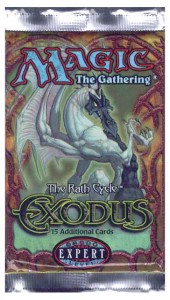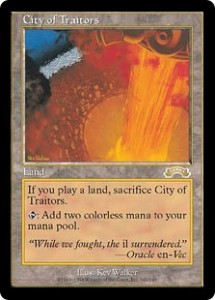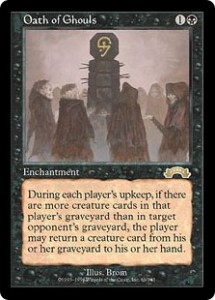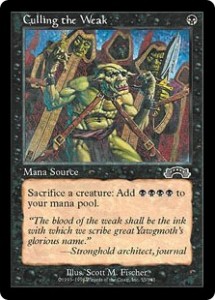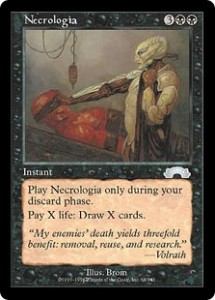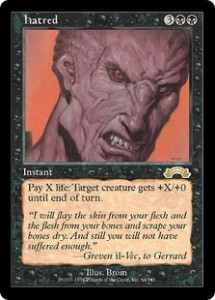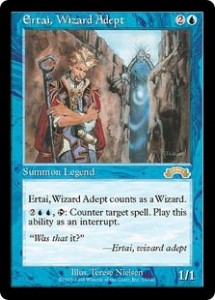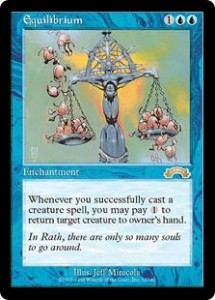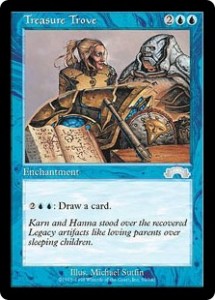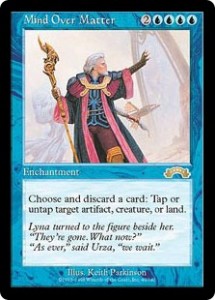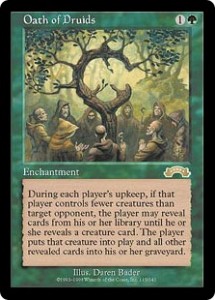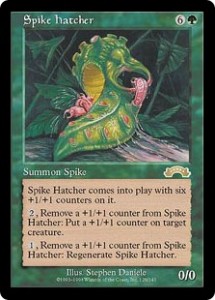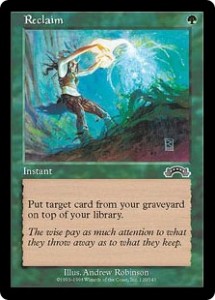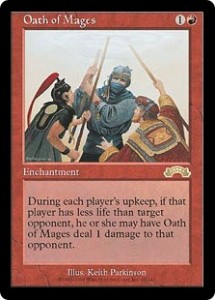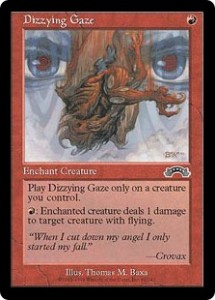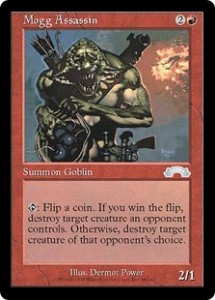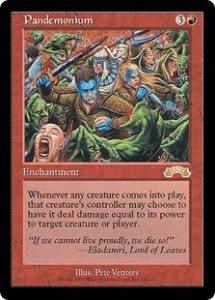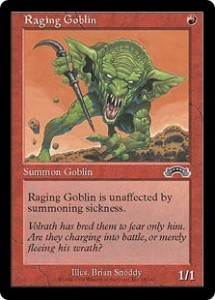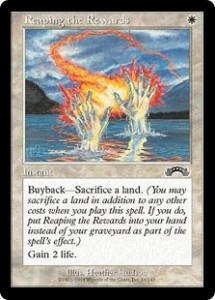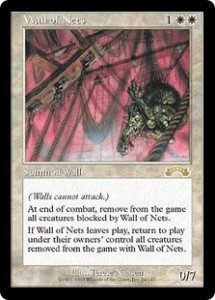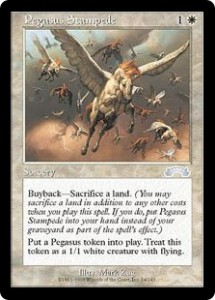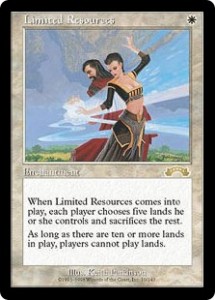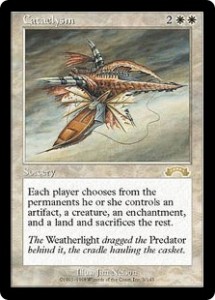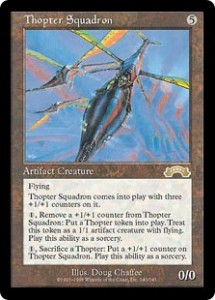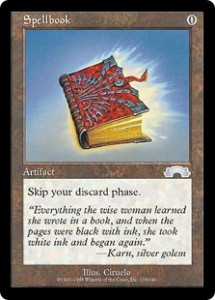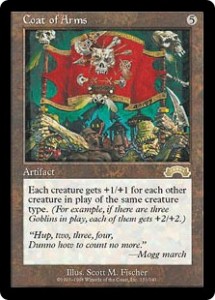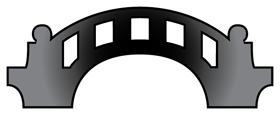
An Introduction to Exodus
Released in June of 1998, Exodus was the end of the Tempest Block, also known as The Rath Cycle. It continued the new standard for 143 card small expansion sets laid out by Stronghold and it was a great end to the Rath Cycle by many measures.
Exodus was the first set in Magic the Gathering to color-code the expansion symbol by rarity; black for common, silver for uncommon and gold for rare. This color-coding would endure until today, where it is still utilized.
The rarity breakdown of 55 commons, 44 uncommons and 44 rares, was the same that Stronghold has used. There were two types of cards that every color had; Keepers and Oaths, in addition to a continuation of the Shadow and Buyback mechanics of it’s two predecessors in The Rath Cycle; Tempest and Stronghold.
The color breakdown was 26 Black cards, 26 Blue cards, 26 Green cards, 26 Red cards, 26 White cards, 12 Artifacts and 1 Land and unlike the rest of The Rath Cycle it was the only set not to include Gold or multi-colored cards.
Exodus introduced Coat of Arms and hatred, a card used so much that the summer of 1998 was known as the Summer of Hate, as well as, bringing Raging Goblin from the exiles of Portal, which many avid players didn’t use, into the fray of tournament play. Raging Goblin was one of only five reprinted cards in Exodus, all of which originally hailed from either Portal or Portal Second Age.
Townsfolk, Elves, Goblins, Merfolk, Knights, Licids, Soldiers, Spikes, Thrulls, Wizards and Zombies, among a few others all appeared within the set.
Continuing to follow in the footsteps of Stronghold, Exodus was also released with four preconstructed theme decks, which included cards from Tempest, Stronghold and Exodus.
Exodus, in addition to the color coding rarity set symbol, also introduced for collector’s a collector number on the bottom of the card with the artist and copyright information, stating the number of the card in the set and how many cards were in the set.
Like Weatherlight did for the Mirage Block, Exodus made a statement as the Tempest Block, The Rath Cycle, came to an end; and that statement was the game is changing. Things are about to get faster and new rules are just around the corner, so don’t get comfortable.
The Land of Exodus: The City of Traitors
The lone land of Exodus, City of Traitors, was interesting. It could be tapped for two colorless Mana, but it had a drawback. “If you play a land, sacrifice City of Traitors.” This is quite the drawback indeed, because there aren’t any ways to get a land into play otherwise.
The two Mana it produced when it was cast, led many to speculate this was the updated, unbroken, version of Sol Ring in the form of a Land. Of course, this was only speculation, I do believe it. Many of the Restricted and Banned cards from the first list of Restricted and Banned cards, came back with version that were similar, only the new versions had a drawback.
That said, there were two schools of thought on when to use City of Traitors. get one or two colored Mana into play and then play it to gain a fast Mana advantage, or wait until the end is in sight and use it for an extra Mana to finish off your opponent. I’m sure, if you wanted to use some of the graveyard to hand or play Land cards, you could just play it whenever, but the deck would have to be built for that.
That being said, it wasn’t the force of nature that Volrath’s Stronghold was as the only Land in Stronghold, but to those who had decks that could mitigate or lessen the drawback of losing the Land, it was a welcome addition.
The Color Black in Exodus: Recurring Nightmare, hatred and much more
Black in Exodus was one of the more offensive set of cards for Black than previous sets. Based on attack, damage and card draw in addition to the classic themes of reanimation and discard.
Keeper of the Dead, Black’s keeper was a Dark Banishing in a creature ability, but only if your opponent had two or fewer creature cards in his or her graveyard than you have in yours, while Black’s Oath, Oath of Ghouls was great for reanimator decks and any deck in general.
Oath of Ghouls, “during each player’s upkeep, if there are more creature cards in that player’s graveyard than in target opponent’s graveyard, the player may return a creature card from his or her graveyard to his or her hand.” But you can’t use this Oath in a discard deck, because you give your opponent a larger choice of what cards to get back, and you’ll probably be unable to use the Oath for yourself.
For discard decks there were three additions in Cat Burglar, Fugue and Entropic Specter. Cat Burglar was a 2/2 that had the ability, as a Sorcery, to make target player discard a card, while Fugue made target player discard three cards, although it cost three colorless and two Black Mana.
Entropic Specter, returned Specters to discard decks, joining the ranks of Abyssal and, the classic, hypnotic Specters. Entroptic Specter had power and toughness equal to the cards in target opponent’s hand, and of course, when it damaged an opponent, it made them discard a card, although not at random.
Reanimator decks loved Mind Maggots, as a way to get creature cards in the graveyard faster, but not as much as they loved Recurring Nightmare which became the centerpiece of many reanimator decks. “Sacrifice a creature, Return Recurring Nightmare to owner’s hand: Put target creature card from your graveyard into play. Play this ability as a sorcery.” As a never ending source of dead creatures, unless Recurring Nightmare was destroyed or countered, this enchantment was beyond what reanimator decks were looking for.
Volrath’s Dungeon was also great for reanimator decks, as well as discard decks, because it allowed you discard a creature you wanted to put into the graveyard to stall your opponent’s draw bu having them put a card from their hand on top of their library. Of course, when they get sick of the charade, they can pay the five life to destroy Volrath’s Dungeon, but until they get to that point, it really is fun.
Two classic cards were remade, in a way, in Exodus. Culling of the Weak was a Dark Ritual that required a creature to be sacrificed but gave you four Black Mana, and the ability had a colon in it, so two creatures could be sacrificed for eight Mana if need be. The other card, Slaughter was a Dark Banishing with “Buyback: Pay 4 life,” but such a cost wasn’t the only hurt Black could do to itself, in the name of destruction.
Carnophage was a cheap 2/2 with a similar upkeep to Juzam Djinn, in that it doesn’t die if you don’t pay it, but it does get tapped unlike Juzam, So it just hurts, one life per upkeep until you, it, or your opponent dies.
The Dauthi clan was still in force with Shadow with Dauthi Jackal, Dauthi Warlord and Dauthi Cutthroat, the Royal Assassin of Shadow creatures.
A Black Spike in Spike Cannibal was added to the set and was a huge sideboard card against Spike decks, because when Spike Cannibal came into play, it moved all +1/+1 counters from all creatures onto itself. For only one colorless and two Black Mana, that’s a cheap cost for what could easily be a 5/5 on turn three. A more staple Black tribe, the Thrulls was given Thrull Surgeon, but for all of Black’s weenie creatures, Exodus had a boost.
Scare Tactics was that boost, either for that final attack or an all out clear-the-board attack, as an Instant that gave all creatures you control +1/+0 until end of turn. It only cost one Black Mana, so if you had them in hand, you could cast two easily enough.
Card advantage is something Black has always had something for and in Necrologia, Black was given an Instant version of Ice Age‘s Necropotence, that could be utilized only during your discard phase. The only drawback was the cost, three colorless and two Black Mana, but for the card draw advantage, it was well worth the price.
Back to the creatures, Pit Spawn was just a huge beast, a 6/4 with a large casting cost that had first strike, an upkeep of two Black Mana, and the additional ability of removing from the game any creature damaged by it. On the other hand, Plaguebearer was a newer more expensive Royal Assassin, by which you paid twice the target creature’s casting cost to destroy that target non-black creature.
The creatures, the spells, reanimation and discard, though great as they were in Exodus, all took a backseat to one card; hatred.
Hatred was a Channel and howl from Beyond in one, and although it cost three colorless and two Black Mana, it was used as a game ender, so if you needed to use Culling of the Weak to cast it, so be it. Hatred was so heavily used, that the summer it came out was known as the “Summer of Hate.”
That’s cool, it was also the first time, one card had so dominated the minds of players (of all colors), and more surprisingly, it was a Black card, not an artifact which all decks could utilize, just one Black card that set the summer ablaze.
Being an “Old School” two-card combo combined into one card, hatred was extremely well received by both new and experienced players.
The Color Blue in Exodus: Control, Card Draw and Control
The control Blue has always had within the game was not diminished in power with Exodus, although the set did take a more basic approach to Blue in creatures and spells in addition to Blue’s control.
Blue’s keeper, Keeper of the Mind, allowed for card draw if target opponent has at least two more cards in their hand hand you have. Oath of Scholars was also based on card draw, allowing each player to discard their hand to draw three cards, if they had fewer cards in hand than target opponent, which was a huge advantage, if you had no hand to begin with.
Of course there was a counterspell, Forbid, a counterspell with the expensive buyback of discarding two cards. Although it was mainly used as just another counter, if needed it could be a great way to maintain a counterspell in hand.
Ertai, Wizard Adept was a legend with the counterspell ability, although the activation cost was two colorless and two Blue Mana, and the legend himself was only a 1/1, if you could protect him, it was great to have a permanent counterspell available to you, when Ertai was in play.
If there is Blue there are Merfolk, such was the nature of consistency in Old School Magic as it was. Merfolk Looter had a simple, draw a card and then discard a card ability, while Rootwater Mystic allowed you to look at the top card of target player’s library, which could be a great advantage.
As Black’s Shadow tribe Dauthi swelled in numbers, so too did Blue’s Shadow tribe of Thalakos. Thalakos Drifters was a 3/3 that could be given Shadow by discarding a card, while Thalakos Scout was a 2/1 that could be returned to your hand by discarding a card.
Merfolk, Thalakos and many other creatures benefited from Cunning, which was essentially a blue Giant Growth but as an enchantment, that was destroyed when the enchanted creature attacked or blocked, instead of an instant.
Curiosity was great with the many Tims that existed; Prodigal Sorcerer, Zuran Spellcaster, Rootwater hunter, etc. It was an enchant creature that stated, “if enchanted creature damages an opponent, you may draw a card.” For the many Tims, this was simply adding card draw to the damage.
AEther Tide was a great Sorcery that let you trade creatures you have in your hand, and don’t need, to boomerang creatures that are hurting you. And with all of Blue’s existing card draw, it was easy to bounce back as much as you wanted to. Also of great value for Blue control decks was Equilibrium, which could easily tip the creature scales in your favor. It allowed you to pay one colorless Mana, when you successfully cast a creature to return target creature to owner’s hand. And Blue had some fun none tribal creatures to cast in Exodus.
Ephemeron was a 4/4 Blue blinking spirit, if you discarded a card to return it to your hand, while similarly, Wayward Soul was a 3/2 flyer that could be returned to the top of your library for one blue Mana. School of Piranha was a cheap one colorless and one Blue Mana costing 3/3, but you had to pay it’s casting cost during it’s upkeep or sacrifice it, while the 3/5 Killer Whale could be given flying until end of turn.
If there is a creature you want to protect, Robe of Mirrors allows you to do that by making enchanted creature unable to be the target of spells or abilities, although it would still fall to Wrath of God, that would be a decent trade in clearing the board of your opponent’s creatures as well.
Mana Breach could slow down even the fastest deck if it was cast early enough. “Whenever any player plays a spell, that player returns a land he or she controls to owner’s hand,” which means if you play with artifact Mana sources, you can easily make it less effect you and really put the grind to your opponent.
Blue’s card advantage was give three more cards with Scrivener, Theft of Dreams and Treasure Trove. Scrivener was epic for Blue, allowing you to return an Instant or Interrupt card from your graveyard to your hand, when you cast the 2/2 townsfolk. When timed properly, Theft of Dreams, draw a card for each tapped creature target opponent controls, allowed for major card draw, especially in Kismet / Stasis decks.
Additionally, Treasure Trove was pure card draw, with a two colorless and two Blue Mana activation cost to draw a card. The better part being that this enchantment could be used whenever and for however many times you needed it, if you had the mana. This was a huge advantage when paired with the best strong-armed control card of Exodus: Mind Over Matter.
Mind Over Matter, had an expensive casting cost at two colorless and four Blue Mana, but it was worth every Mana. “Choose and discard a card: Tap or untap target artifact, creature, or land.” With Blue’s card draw advantage and the ability of many graveyard manipulation cards to get discarded cards back, this kind of control was very useful. Especially, in cases when it was paired with other lockdown cards, such as Propaganda, Meekstone and Winter Orb. With Mind Over Matter in play and one or more of the lockdowns in effect, good luck breaking out of the hold.
The Color Green in Exodus: Elves, Mana, and Survival of the Fittest
Green in Exodus continued to focus on creatures, moving away from the important enchantments of previous sets and getting back to its roots.
Green’s keeper in Keeper of the Beasts allowed you to make a 2/2 Beast token if your opponent controlled more creatures than you. It’s oath in Oath of the Druids, allowed each player to Mill themselves if an opponent had more creatures than they did and put the first creature card picked from the milling into play. Early on, this could cheaply cast very large creatures.
Green is of course ruled by the Elves and of course the tribe made expanded in Exodus. Elvish Berserker was a 1/1 that got a +1/+1 boost for each creature that blocked it. Wood Elves, allowed you to search your library for a basic forest and put it into play, when the 1/1 creature was cast, which is why it cost two colorless and one Green Mana, for a mere 1/1.
Lastly, from a creature standpoint for the Elves was Skyshroud Elite, which was a 1/1, but got a boost of +1/+2, if any opponent controlled any nonbasic lands, which was becoming more and more common as the library of nonbasic lands increased after each new set.
Elven Palisade, was an enchantment of huge import to Elf decks. It allowed you to sacrifice a Forest to give target attacking creature -3/-0 until end of turn, rendering some big creatures blockable by elves, whether they were boosted by something further, Instants or Enchants, or not.
Of course, Elves weren’t the only big tribe in Exodus for Green, there was the continued expansion of the new Thallid-like Spike tribe, with Spike hatcher, Spike Rogue and Spike Weaver.
The hatcher came into play with six +1/+1 tokens on it, that could be moved to another creature or sacrificed to regenerate the hatcher. The Rogue could move +1/+1 counter to other creatures or from other creatures onto itself and the Weaver could give +1/+1 tokens or sacrifice them to create a Fog.
Jackalope herd was a cheap 4/5 at just three colorless and one Green Mana, but it’s drawback was steep. “If you play any spell, return Jackalope herd to owner’s hand.” This meant that in order to really use this cheap 4/5, you had to hold onto your hand or use abilities to get creatures and land into play, which wasn’t hard for Green to do anyway.
Mirri, Cat Warrior was a 2/3 legend that counted as a cat warrior. Mirri only cost one colorless and two Green Mana, which is a bargain considering this cat warrior had first strike, forestwalk and attacking does not cause it to tap. Although, for as good as Mirri was, there was one creature that stole some of the show in Green, as far as creatures were concerned; Cartographer.
Cartographer, a 2/2 townsfolk for two colorless and one Green Mana, was a great play after Armageddon in the many variations of ‘geddon decks that now were in existence. “When Cartographer comes into play, you may return target land card from your graveyard to your hand.” This was great, because most Green deck’s had other sources of Mana, so Cartographer could be cast the turn after the Armageddon in most cases.
Although not quite receiving the acclaim is should have Reclaim was an updated version of Regrowth, last seen in Revised, to the dismay of many players of Green.
The only difference being that Regrowth put target card from your graveyard into your hand, while the newly printed Reclaim, but that card on top of your library instead. Still, it was a great way to get back something that had been used or destroyed.
In Green weenie decks, 1/1 creatures are destroyed often to be replaced by more 1/1 creatures or even larger creatures and Bequeathal, only aided in speeding up this process. “If enchanted creature is put into any graveyard, draw two cards.”
For Green, and more specifically Elf decks, this kind of card draw was a great advantage, often being able to draw another creature to replace the deceased.
Manabond was a huge Mana advantage with a bit of risk. During your upkeep, you may put all Lands from your hand into play, but you must discard the rest of your hand. When paired with library manipulation like Sylvan Library and other similar cards, the risk is much less, but if you don’t know what your draw is, be careful with what you may throw away with the rest of your hand.
The ultimate Green enchantment of the set and arguably of the whole Rath Cycle was Survival of the Fittest. It allowed you to discard a creature card to search your library for a creature card, reveal that card to all players and then put that card into your hand.
What this does, is make any creature in your hand, in reality, any creature in your deck with just a pitch to the graveyard. As with many Green decks, sacrificing a lowly, but useful, Llanowar Elves for something big or more useful, early or late on in the game is a huge advantage. One that many Green decks initiated once Survival of the Fittest was printed.
The Color Red in Exodus: More Destruction and Power than Damage
The was one thing missing from Red in Exodus, a lot of direct damage, but it made up for it with some extremely useful cards, for almost any Red deck, or even any deck with Red in it.
Red’s keeper, Keeper of the Flame allowed you to deal two damage to target opponent, but only if that opponent has more life than you. The Keeper, when combined with Red’s oath, Oath of Mages, kept you ahead of the curve. The Oath of Mages said that each player, during their upkeep, may have the Oath deal one damage to that player, again, provided he or she has more life than you.
There was some direct damage, Sonic Burst was cheap, but made you discard a card at random in order to deal 4 damage to target creature or player, however it was a colon, so two cards could be discarded for eight damage and so on.
Mage il-Vec was also a discard a card at random type of risk and only for one damage to target creature or player. Personally, I prefer Lightning Bolt, but I would take a Shock over the Mage, as discarding a card at random for one damage isn’t worth it in my book.
Instead of the Mage, what about making any creature you control a Tim that targets flying with Dizzying Gaze. Which allowed enchanted creature to deal one damage to target flying creature for the activation cost of one Red Mana, it didn’t even have to tap, so it could be used many times over in a single turn.
Red was re-gifted with some classic cards being reprinted with Buyback; Flowstone Flood the (expensive) Buyback Stone Rain and Shattering Pulse the Buyback Shatter, both were useful, but neither was used quite that much.
In Red, the direct damage Sorcery cards were given a wonderful ally in Anarchist, which allowed you to return target Sorcery card from your graveyard to your hand when cast. The only downside was, at that time, all of the really great spells you’d want to use over and over were mainly Instants, but it was still a great addition to the Red arsenal.
The heir apparent to Blood List was Maniacal Rage. Although not a straight +4/-4, like Blood Lust and not an Instant either, it did give enchanted creature +2/+2 and made the creature unable to block. This is fine, as most of the time, Blood Lusted creatures were attacking anyway.
There were plenty of big creatures too, Monstrous hound was a cheap 4/4 for land destruction decks, in that it could only attack or block if you controlled more Lands than target opponent. Ogre Shaman was a 3/3 with the Stormbind ability.
The flip a coin cards had two more cards added to their ranks in Fighting Chance and Mogg Assassin. Fighting Chance, an Instant that allowed you to flip a coin to determine whether or not blocking creatures deal combat damage and it was done for each blocker. Mogg Assassin on the other hand allowed you to Tap it and flip a coin to destroy target creature an opponent controls. If the flip ends up in your opponent’s favor they get to destroy target creature you control. As much as Fighting Chance had flip a coin in it, it was Mogg Assassin that was the real gamble.
Speaking of gambling Paroxysm was great because it could give enchanted creature +3/+3 until end of turn. It was a gamble, when not paired with library manipulation because during the upkeep of the creatures controller, that player must reveal the top card in their library, if the revealed card is a land destroy that creature, otherwise it gets the +3/+3 boost. Of course, you could also play it on your opponent’s creature and wait for them to draw a land and watch the creature go boom.
Spellshock was simply a nasty card, dealing to damage to any player that successfully casts a spell. This could be dangerous, but could stall your opponent for a time, as well.
While Spellshock put the hurt to anyone playing a spell, Price of Progress put the hurt to each player for each nonbasic land he or she controls.
Pandemonium was pure chaos for every player involved in the game. “Whenever any creature comes into play, that creature’s controller may choose to have it deal damage equal to its power to target creature or player.” Because it could hurt both players equally it was always played with caution.
Seismic Assault was your own personal Land’s Edge. Much better than it’s predecessor originally printed in Legends and reprinted in Chronicles, because the Assault could only be activated by you and wasn’t available for any player. But the card that everyone talked about from Exodus in Red was just a common, and a Portal reprint at that; Raging Goblin.
Raging Goblin was a standout of the set, because it was Raging Goblin’s first foray into tournament play, as Portal wasn’t tournament legal.
Why was a 1/1 Goblin for one Red Mana, that was unaffected by summoning sickness such a big deal? Because this is Red. Because at that time, Red was the most aggressive of all the colors and to have a first turn attacker for just one Mountain, was a huge advantage, allowing players to hold onto their Shocks or Lightning Bolts for other turns, while taking their opponent down to 19 life with almost no effort at all.
The Color White in Exodus: Life Gain, Life Gain, and a New Addition to the Pantheon of White Mass Destruction
White in Exodus fell back to its roots, a few big creatures, protection, powerful destruction, life gain and helpful enchantments.
Keeper of the Light, White’s keeper, allowed you to gain three life, but only if you had less life than target opponent, while it’s oath, Oath of Lieges was a little more helpful, although it did help both players. Oath of Lieges was a Land Tax for everyone, so although it was a great play for you, it was just a great play for your opponent as well. The fact that it was for all players hindered its use, so it saw limited play.
White’s life gain abilities were not contained to Keeper of the Light; Convalescence, Peace of Mind, Soul Warden and Reaping the Rewards were additional ways to gain life.
Convalescence allowed you to gain one life during your upkeep if you have ten or less life, while Peace of Mind allowed you to discard a card to gain three life. Soul Warden a 1/1 cleric gained you one life whenever any other creature comes into play, but the highlight of them all was Reaping the Rewards.
Reaping the Rewards was an Instant with Buyback form of Ice Age‘s Zuran Orb. It cost one White Mana to cast and allowed you to gain two life, but it had a Buyback cost of sacrifice a land, which is why it was and still is so heavily compared to the once restricted and banned artifact.
Another Buyback spell for White was Allay, which could destroy target enchantment, but it was lamented as a card, because a Buyback Disenchant would have been much better, at least that was the prevailing attitude of the time.
As with many of the other colors, White’s Shadow tribe of the Soltari was also boosted by Exodus, with the printing of Soltari Visionary, which had the added bonus of being able to destroy target enchantment that opponent controls if that opponent is damaged by the Visionary.
The big creature for White in Exodus was Exalted Dragon, a 5/5 dragon with flying, but it had a drawback. It could only attack, if you sacrificed a Land, but when paired with the Land recovery of Green, this wasn’t something to hold you back from attacking with it.
Treasure hunter followed in the footsteps of Anarchist and Cartographer as a 2/2 that returned something from your graveyard to your hand, only the hunter returned target artifact, which for White, having been utilizing artifacts with enchantments since almost the beginning of Magic, this was a great advantage. Meanwhile, as a best of both worlds card, Zealot en-Dal was a 2/4 that would gain you one life during your upkeep, if all nonland permanents you control are White.
The renaissance of Walls wasn’t limited to Stronghold as Exodus’s Wall of Nets was superb. As a 0/7, this wall removes from the game all creatures blocked by Wall of Nets at the end of combat. Those creatures do not return to play until Wall of Nets leaves play. This is a great way to deal with those pesky 1/1’s that your opponent insists on attacking with, because if they attack, they lose them. Remember a 0/7, even as a Wall, isn’t the easiest thing to kill.
There were other ways to pacify creatures as well, such as Shackles, which was a movable Pacifism for creatures that were already or could be tapped. That it was movable from one creature to another made it extremely useful as a game would go after a while.
Reaping the Rewards wasn’t the only Buyback of note that made you sacrifice a Land for it’s Buyback cost, it shared that cost with Pegasus Stampede. Pegasus Stampede allowed you to put a 1/1 flying Pegasus token into play. Is the trade of a Land for a 1/1 flyer a good one? Usually, but you have to be careful not to sacrifice too many lands and handcuff yourself.
The enchantment of high Ground, really was extremely useful, as it allowed each creature you control to block one additional creature. If you have a Wall of Net or two in play, this was a huge advantage, in clearing the board or even just preventing the attack to begin with.
Meanwhile, for White decks, especially White weenie decks, Limited Resources was a huge advantage. It made each player sacrifice Land down to five, and then stated as long as there are ten or more Lands in play, players cannot play land.
Now for decks that only rely on five Mana max to cast everything in their library this is a huge advantage, because you have all the Land you need.
Limited Resources also spawned the Red / White Land destruction deck, as once each player had five lands, the Red part of the deck, could destroy a Land, and then you could play a Land to keep the total Land in play at ten, but giving you a six to four advantage, then repeating the process until you had all ten Land, leaving your opponent Mana-less and in most cases hopeless.
White’s power destruction cards are on a pantheon by themselves; Armageddon, Balance, and Wrath of God. But in Exodus, a card was printed that joined them in ability and in that pantheon; Cataclysm.
Cataclysm cost two colorless and two White Mana was huge as the “new Balance.” “Each player chooses from the permanents he or she controls an artifact, a creature, an enchantment, and a land and sacrifices the rest.”
This kind of selective destruction was great at a time when combo decks were the norm. It leveled the playing field in an uneven way most of the time, and could be the last card you play. Either you win or you lose, but playing it was either an offensive move to get ahead in the game, or a last resort to hold on.
It didn’t matter, though, how it was used. Just as an ability and spell, it joined the pantheon and made White even more powerful, in terms of mass destruction.
The Artifacts of Exodus: Coat of Arms Overshadowed all of the Rest
There were 12 Artifacts in Exodus, and for such a small amount there were plenty that had impact.
Sure Medicine Bag was useful for creature regeneration, Mindless Automaton for card draw and a potentially big creature, Skyshaper for making your all out attack that of all flyers and Sphere of Resistance was great for slowing down a game, it was the other eight that stood above the rest.
The Licids were a concoction of the Rath Cycle sets and in Exodus at the end, there was in fact an artifact licid in Transmogrifying Licid. Thopter Squadron was a something that most players saw as an upgraded Clockwork Avian, in that it’s +1/+1 counters could be moved off as 1/1’s in their own right or those 1/1’s could be moved back to being +1/+1 counters. This was a truly multidimensional creature.
Workhorse, also used +1/+1 counters, but was more like Mirage’s Wall of Roots, where you could remove a counter for Mana, although Workhorse only gave you colorless Mana, it was still useful.
Memory Crystal was great because it reduced all Buyback costs by two colorless Mana, which was much bigger for the Buyback cards of Tempest, before Stronghold and Exodus starting adding life and sacrificing various permanents to those Buyback costs.
Erratic Portal was beautiful in the right deck, as it was a Force Spike Boomerang, where target creature would be bounced back to its owner’s hand unless that owner paid one colorless Mana, which of course, was usually timed to be used when the cost couldn’t be paid.
This was particularly deadly after an Armageddon, when big creatures would get bounced back to their Mana-less owner’s hands.
Null Brooch was one of the more dangerous artifacts to ever be printed. Sure, it only countered target noncreature spell and sure, you had to discard your hand to do it, but it was an artifact and cost two colorless Mana to activate. This brought a certain level of Counterspell to every color, which in some non-Blue decks was a very dangerous combination.
Spellbook was the much simplified Library of Leng of its day. “Skip your discard phase,” which for many was great with all the new card draw of the Ice Age Block, Mirage Block and Tempest Block or The Rath Cycle.
The only downside that it didn’t carry over from Library of Leng was the ability to discard cards to the top of your library, but again this was a very simplified version.
There is but one card left to discuss of the set of Exodus that completed the Rath Cycle and it was a card that changed tribal decks forever; Coat of Arms.
Coat of Arms, “each creature gets +1/+1 for each other creature in play of the same creature type. (For example, if there are three Goblins in play, each of them gets +2/+2.)
The flavor text of “Hup, two, three, four, Dunno how to count no more,” which was a Mogg march, was interestingly enough one of the problems with the card.
Elf and Goblin decks really had that problem. Both decks were always focused on getting large quantities of small creatures out in a hurry. Once that was completed, cast the Coat of Arms and then start the clock. Why the clock? Because it would take some time to count all the creatures and do the math.
It wasn’t hard, but with the advent of so many Goblins and Elves that were 1/2, or 2/2, it was more about keeping track of who was what after the boost, than it was figuring out the boost. Then again, after an attack, trying to figure out who dies and when the boost ended was a source of many arguments as well. And don’t get me started on Goblin v. Goblin decks and Elf v. Elf decks.
All in all, there never was and there hasn’t been another artifact that did more for the tribal deck then Coat of Arms did. That’s just the way it was.
In Conclusion Exodus
Given the three sets to a Block template started back with Ice Age, Exodus was many things. As with Alliances ending the Ice Age Block and Weatherlight ending the Mirage Block, Exodus was a clean ending to the Tempest Block or The Rath Cycle.
In fact, it was so clean that it had a standout card in every color; hatred, Mind Over Matter, Survival of the Fittest, Raging Goblin, Cataclysm and Coat of Arms. But the end of a Block had come to signify more than just a new Block on the horizon.
With each new Block, Ice Age, Mirage, and Tempest new rules were inked and sometimes old ones were blotted out. Although Exodus wasn’t the most influential of the expansions since Ice Age, it was important. Not just because it ended The Rath Cycle, but because it ended the Rath Cycle on a completionist’s balance note that was most powerful and is what is most remembered of Exodus, as we look back on it.
